Monday, August 6th 2018

AMD Announces 2nd Generation Ryzen Threadripper 2000, up to 32 Cores/64 Threads!
AMD announced its second-generation Ryzen Threadripper high-end desktop (HEDT) processor series, succeeding its lean and successful first-generation that disrupted much of Intel's Core X HEDT series, forcing Intel to open up new high-core-count (HCC) market segments beyond its traditional $1000 price-point. AMD's 16-core $999 1950X proved competitive with even Intel's 12-core and 14-core SKUs priced well above the $1200-mark; and now AMD looks to beat Intel at its game, with the introduction of new 24-core and 32-core SKUs at prices that are sure to spell trouble for Intel's Core X HCC lineup. The lineup is partially open to pre-orders, with two SKUs launching within August (including the 32-core one), and two others in October.
At the heart of AMD's second-generation Ryzen Threadripper is the new 12 nm "Pinnacle Ridge" die, which made its debut with the 2nd Generation Ryzen AM4 family. This die proved to introduce 3-5 percent IPC improvements in single-threaded tasks, and multi-threaded improvements with an improved Precision Boost II algorithm, which boosted frequencies of each of 8 cores on-die. The Threadripper is still a multi-chip module, with 2 to 4 of these dies, depending on the SKU. There are four of these - the 12-core/24-thread Threadripper 2920X, the 16-core/32-thread Threadripper 2950X; the 24-core/48-thread Threadripper 2970WX, and the flagship 32-core/64-thread Threadripper 2990WX.The pricing of these chips is sure to shock you. The 12-core/24-thread 2920X is priced at just $649.99, or $150 cheaper than its predecessor, the 1920X, which already proved faster than the 10-core/20-thread Core i9-7900X in multi-threaded tasks. This SKU should disrupt Intel's pitifully configured 8-core/16-thread Core i7-7820X and 6-core/12-thread i7-7800X; and its pricing could be strategic in taking some of the attention away from Intel's upcoming Core i9-9900K.
Next up, is the 16-core/32-thread TR-2950X. This chip can be yours for $899.99, which again, is $100 cheaper than its predecessor.
At this point, you'll notice why the higher core-count SKUs have a "WX" extension, while the 12-core and 16-core parts have just "X." This is because AMD is targeting the 24-core and 32-core parts at pro-sumers, while the 12-core and 16-core ones are targeted at high-end gaming PC builds.
The 24-core TR-2970WX is priced at $1,299.99, bang on par with Intel's 14-core i9-7940X (you get 10 fewer cores with Intel). The flagship TR-2990WX is priced at $1,799, or about $100 cheaper than Intel's flagship, the 18-core/36-thread Core i9-7980XE. You get a whopping 14 more cores.
All four SKUs are drop-in compatible with existing socket TR4 motherboards based on AMD X399 chipset, requiring a BIOS update. All X399 motherboards on the market support USB flashback, so a previous-generation CPU is not required to flash to the latest BIOS.
The 4-die 2970WX and 2990WX should logically have 8 memory channels and up to 128 PCIe lanes, because you are adding up the connectivity of all four dies on the MCM; however, there are no socket TR4 motherboards in the market or on the horizon, which have 8-channel memory slots, or PCIe slots that utilize all those PCIe lanes. "Drop-in compatibility" with existing X399 motherboards could hint at the likelihood of the 4-die, 24-core and 32-core SKUs probably only having quad-channel DDR4 memory interface, and just 64 PCIe lanes.
How AMD is wiring the dies out on the 24-core and 32-core MCMs remains a mystery. We know from how EPYC is wired out, that the SP3r2/TR4 socket has four distinct "zones," each corresponding to a die. Wiring out 1 memory channel per die may neither be possible nor desirable. It may not be possible because current socket TR4 motherboards are built for MCMs with just two active dies, the diagonally-opposite ones, and as such the memory wiring of the four channels terminate at the pins of those two active dies; it may not be desirable either, because one memory channel per die would severely cripple memory bandwidth for single-threaded or less-parallelized tasks that AMD likes to localize to one die with dual-channel memory access.
The same logic could apply to PCIe. PCI-Express 3.0 x16 slots and M.2-NVMe slots on existing boards are wired to terminate at the two diagonally-opposite "active" dies of the first-generation Threadrippers. This could mean that the two additional active dies on the 24-core and 32-core SKUs rely on the Infinity Fabric interconnects to access memory and PCIe devices. On the 4-die EPYC MCMs, each die is connected to the three other dies using an Infinity Fabric link. Each link has a 25.6 GB/s (per-direction) bandwidth.
It's probably for this reason, that the 2970WX and 2990WX are targeted more at pro-sumers who actually use software that can utilize those many cores; while the 2920X and 2950X are targeted at high-end gaming builds, in which you're gaming, streaming, and doing a whole bunch of other things in tandem.
Taking advantage of the 12 nm "Pinnacle Ridge" die, AMD increased clock-speeds across the board. The 2920X is clocked at 3.50 GHz, with 4.30 GHz boost, compared to the 3.50/4.00 GHz clocks of its predecessor. The 2950X is clocked at 3.50 GHz with 4.50 GHz boost, a 500 MHz increase in boost frequencies from its predecessor. The TDP of both SKUs is unchanged, at 180W. The doubling in core-count for the two WX SKUs doesn't linearly increase TDP, despite impressive clocks. The 24-core 2970WX is clocked at 3.00 GHz with 4.20 GHz boost (higher than the max boost of the 1950X). The 32-core 2990WX has identical clock speeds as the 2970WX. Both the 24-core and 32-core chips have 250W TDP.
AMD began taking in pre-orders for the 32-core flagship Ryzen Threadripper 2990WX, which is priced at $1,799.99, which will be generally available from August 13, 2018. The 16-core 2950X will be available from August 31st. The 24-core and 12-core SKUs will be available in October.AMD's press-deck for today is posted verbatim below.
At the heart of AMD's second-generation Ryzen Threadripper is the new 12 nm "Pinnacle Ridge" die, which made its debut with the 2nd Generation Ryzen AM4 family. This die proved to introduce 3-5 percent IPC improvements in single-threaded tasks, and multi-threaded improvements with an improved Precision Boost II algorithm, which boosted frequencies of each of 8 cores on-die. The Threadripper is still a multi-chip module, with 2 to 4 of these dies, depending on the SKU. There are four of these - the 12-core/24-thread Threadripper 2920X, the 16-core/32-thread Threadripper 2950X; the 24-core/48-thread Threadripper 2970WX, and the flagship 32-core/64-thread Threadripper 2990WX.The pricing of these chips is sure to shock you. The 12-core/24-thread 2920X is priced at just $649.99, or $150 cheaper than its predecessor, the 1920X, which already proved faster than the 10-core/20-thread Core i9-7900X in multi-threaded tasks. This SKU should disrupt Intel's pitifully configured 8-core/16-thread Core i7-7820X and 6-core/12-thread i7-7800X; and its pricing could be strategic in taking some of the attention away from Intel's upcoming Core i9-9900K.
Next up, is the 16-core/32-thread TR-2950X. This chip can be yours for $899.99, which again, is $100 cheaper than its predecessor.
At this point, you'll notice why the higher core-count SKUs have a "WX" extension, while the 12-core and 16-core parts have just "X." This is because AMD is targeting the 24-core and 32-core parts at pro-sumers, while the 12-core and 16-core ones are targeted at high-end gaming PC builds.
The 24-core TR-2970WX is priced at $1,299.99, bang on par with Intel's 14-core i9-7940X (you get 10 fewer cores with Intel). The flagship TR-2990WX is priced at $1,799, or about $100 cheaper than Intel's flagship, the 18-core/36-thread Core i9-7980XE. You get a whopping 14 more cores.
All four SKUs are drop-in compatible with existing socket TR4 motherboards based on AMD X399 chipset, requiring a BIOS update. All X399 motherboards on the market support USB flashback, so a previous-generation CPU is not required to flash to the latest BIOS.
The 4-die 2970WX and 2990WX should logically have 8 memory channels and up to 128 PCIe lanes, because you are adding up the connectivity of all four dies on the MCM; however, there are no socket TR4 motherboards in the market or on the horizon, which have 8-channel memory slots, or PCIe slots that utilize all those PCIe lanes. "Drop-in compatibility" with existing X399 motherboards could hint at the likelihood of the 4-die, 24-core and 32-core SKUs probably only having quad-channel DDR4 memory interface, and just 64 PCIe lanes.
How AMD is wiring the dies out on the 24-core and 32-core MCMs remains a mystery. We know from how EPYC is wired out, that the SP3r2/TR4 socket has four distinct "zones," each corresponding to a die. Wiring out 1 memory channel per die may neither be possible nor desirable. It may not be possible because current socket TR4 motherboards are built for MCMs with just two active dies, the diagonally-opposite ones, and as such the memory wiring of the four channels terminate at the pins of those two active dies; it may not be desirable either, because one memory channel per die would severely cripple memory bandwidth for single-threaded or less-parallelized tasks that AMD likes to localize to one die with dual-channel memory access.
The same logic could apply to PCIe. PCI-Express 3.0 x16 slots and M.2-NVMe slots on existing boards are wired to terminate at the two diagonally-opposite "active" dies of the first-generation Threadrippers. This could mean that the two additional active dies on the 24-core and 32-core SKUs rely on the Infinity Fabric interconnects to access memory and PCIe devices. On the 4-die EPYC MCMs, each die is connected to the three other dies using an Infinity Fabric link. Each link has a 25.6 GB/s (per-direction) bandwidth.
It's probably for this reason, that the 2970WX and 2990WX are targeted more at pro-sumers who actually use software that can utilize those many cores; while the 2920X and 2950X are targeted at high-end gaming builds, in which you're gaming, streaming, and doing a whole bunch of other things in tandem.
Taking advantage of the 12 nm "Pinnacle Ridge" die, AMD increased clock-speeds across the board. The 2920X is clocked at 3.50 GHz, with 4.30 GHz boost, compared to the 3.50/4.00 GHz clocks of its predecessor. The 2950X is clocked at 3.50 GHz with 4.50 GHz boost, a 500 MHz increase in boost frequencies from its predecessor. The TDP of both SKUs is unchanged, at 180W. The doubling in core-count for the two WX SKUs doesn't linearly increase TDP, despite impressive clocks. The 24-core 2970WX is clocked at 3.00 GHz with 4.20 GHz boost (higher than the max boost of the 1950X). The 32-core 2990WX has identical clock speeds as the 2970WX. Both the 24-core and 32-core chips have 250W TDP.
AMD began taking in pre-orders for the 32-core flagship Ryzen Threadripper 2990WX, which is priced at $1,799.99, which will be generally available from August 13, 2018. The 16-core 2950X will be available from August 31st. The 24-core and 12-core SKUs will be available in October.AMD's press-deck for today is posted verbatim below.
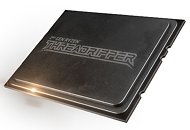
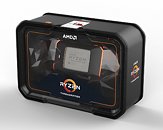

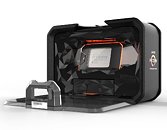
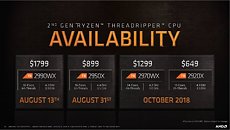
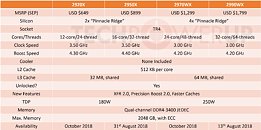


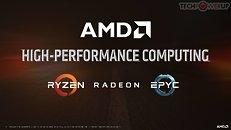


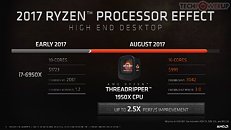
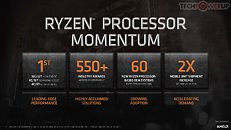


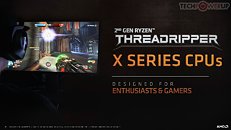
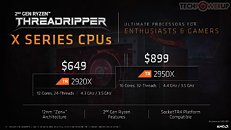
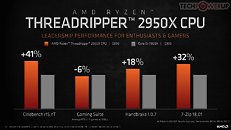



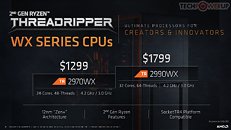
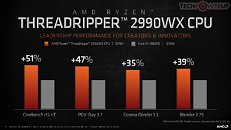

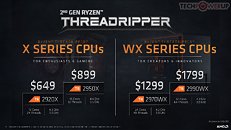


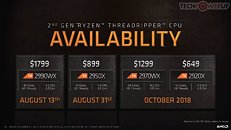






70 Comments on AMD Announces 2nd Generation Ryzen Threadripper 2000, up to 32 Cores/64 Threads!
But that's ok, Threadripper is not supposed to be a mass-market part anymore than Intel's HEDT was.
PS If plenty of people could use 32 cores, how come so many people are happily ditching desktops for laptops and even tablets?
www.amd.com/en/products/cpu/amd-ryzen-threadripper-2990wx
DDR4-2933 is certainly a decent speed, and I think almost no one will be bottlenecked by that. But those wanting ECC might have to wait a bit for DDR4-2933 ECC.
-6% in gaming is rather awful, considering this is where i9 7900x also sucks.
I wonder if all samples of these are able to handle DDR4-3200 14-14-14-28-1T (at what voltage?) over time? I've seen samples of Kaby Lake not able to run it at all. And don't forget that memory controllers do also degrade over time…
Given memory capable of doing that (which I must admit is not very cheap) any Xen+ based (2000 series) Ryzen/TR should be able to run that. Good RAM kits should do that at 1.35V I believe.
Everyone building PC's right now is getting robbed.
~4.2% overall perf. increase for %25 more cores and %67 more cost in the case of 7900x.
and ~2% increase for %50 more cores and %100 more cost in the case of 7920x.
So it looks that Adobe premiere just doesnt benefit from more than 8c/16th effeciently
Was going for $249 on Amazon